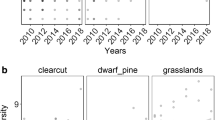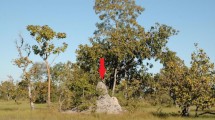Abstract
The spread of exotic plants represents a new challenge for conservation management since practices commonly used to maintain semi-natural, open vegetation may promote the establishment of plant invaders. Panicum acuminatum Swartz is a perennial grass native to America that was naturalized in southern European heathlands. The effect of conservation management on the spread of this invasive species was studied in a heathland in NW Italy along an experimental disturbance gradient created by mowing, grazing, prescribed fire or various combinations of these treatments. Across treatments, the abundance of Panicum acuminatum was negatively correlated with the total abundance of the two dominant native species, Calluna vulgaris and Molinia arundinacea. The abundance of P. acuminatum differed significantly among treatments depending on the intensity and frequency of disturbance (phytomass removal). Thus, its abundance was highest in the repeated fire treatments as well as in the combined fire + grazing and fire + mowing treatments. Following these results, low-severity practices (grazing, mowing, occasional fire) seem most suitable to both reduce tree encroachment and control P. acuminatum spread.
Riassunto
La diffusione di piante esotiche rappresenta una nuova sfida per la gestione con finalità conservative, in quanto pratiche gestionali comunemente utilizzate per mantenere alcune cenosi semi-naturali possono promuovere la presenza di specie invasive. Panicum acuminatum Swartz è una graminea perenne originaria dell’America, naturalizzata nelle brughiere del Sud Europa. L’effetto delle pratiche gestionali sulla diffusione della specie è stata studiato in una brughiera planiziale dell’Italia Nord-occidentale, lungo un gradiente di disturbo simulato sperimentalmente mediante l’impiego di fuoco prescritto, pascolamento, sfalcio e delle loro combinazioni. La presenza di Panicum acuminatum è risultata negativamente correlata con l’abbondanza totale delle due specie autoctone dominanti, Calluna vulgaris e Molinia arundinacea. L’effetto di ciascun trattamento ha evidenziato differenze significative su P. acuminatum, in relazione all’intensità e alla frequenza del disturbo (rimozione di fitomassa). L’abbondanza della specie è risultata più alta nei trattamenti che prevedono l’impiego ripetuto del fuoco prescritto e nei trattamenti con uso combinato fuoco + pascolamento e fuoco + sfalcio. Sulla base dei risultati ottenuti, le pratiche gestionali a ridotta intensità di disturbo (pascolamento, sfalcio, fuoco prescritto occasionale) appaiono più indicate, sia per ridurre l’invasione delle specie legnose, sia per contenere la diffusione di P. acuminatum.





Similar content being viewed by others
References
Almeida ARP, Rodrigues TJD, Santos JM (2000) Allelopathy of Panicum maximum Jacq. cultivars on tree and shrub forage legumes. I. Laboratory evaluations. Bol Ind Anim 57:113–127
Ascoli D, Beghin R, Ceccato R, Gorlier A, Lombardi G, Lonati M, Marzano R, Bovio G, Cavallero A (2009) Developing an Adaptive Management approach to prescribed burning: a long-term heathland conservation experiment in north-west Italy. Int J Wildland Fire 18:727–735
Bagnouls F, Gaussen H (1957) Les climats biologiques et leur classification. Ann Georgr 66:193–220
Begum I, Hussain F (1980) Allelopathic effects of Panicum antidotale Retz. Pak J Sci Ind Res 23:182–188
Besançon H, Comps R, Vriot B (1971) Un Panicum de l’Est de l’Amérique du Nord adventice dans les landes girondines. Cah Nat (Bull Natural Parisiens) 26(3):61–64
Biancotti A, Bellardone G, Bovo S, Cagnazzi B, Giacomelli L, Marchisio C (1998) Distribuzione regionale di piogge e temperature. Vol I. Collana studi climatologici in Piemonte. Cima Icam, Torino
Borghesio L (2004) Biodiversity erosion in the Vauda Nature reserve (Turin, Piedmont, NW Italy). Riv Piem St Nat 25:371–389
Byram GM (1959) Combustion of forest fuels. In: Davis KM (ed) Forest fire: control and use. Mc Graw Hill, New York
Cole DN (1995) Experimental trampling of vegetation. I. Relationship between trampling intensity and vegetation response. J Appl Ecol 32:203–214
Conti F, Abbate G, Alessandrini A (2005) Annotated checklist of the italian vascular flora. Palombi Ed, Roma
D’Antonio CM, Vitousek PM (1992) Biological invasion by exotic grasses, the grass/fire cycle, and global change. Annu Rev Ecol Syst 23:63–87
Daget P, Poissonet J (1971) Une métode d’analyse phytologique des prairies. Ann Agron 22:5–41
DeSelm HR, Clebsch EEC, Nichols GM, Thor E (1974) Response of herbs, shrubs and tree sprouts in prescribed-burn khardwoods in Tennessee. In: Komarek R (ed) Annual Tall Timbers fire ecology conference. Tall Timbers Research Station, Tallahassee, pp 331–344
Gallet S, Rozé F (2001) Resistance of Atlantic Heathlands to trampling in Brittany (France): influence of vegetation type, season and weather conditions. Biol Cons 97:189–198
Gallet S, Rozé F (2002) Long-term effect of trampling on Atlantic Heathland in Brittany (France): resilience and tolerance in relation to season and meteorological conditions. Biol Cons 103:267–275
Gould FW, Clark CA (1978) Dichanthelium (Poaceae) in the United States and Canada. Ann Mo Bot Gard 65:1088–1132
Hobbs RJ, Huenneke LF (1992) Disturbance, diversity, and invasion, implication for conservation. Conserv Biol 6:324–337
Huston MA (2004) Management strategies for plant invasion: manipulating productivity, disturbance, and competition. Divers Distrib 10:167–178
Jonasson S (1988) Evaluation of the point intercept methods for the estimation of plant biomass. Oikos 52:101–106
Larson DL, Anderson PJ, Newton W (2001) Alien plant invasion in mixed-grass prairie: effects of vegetation type and anthropogenic disturbance. Ecol Appl 11:128–141
Lonati M, Aceto P, Falchero L, Lombardi G, Martinasso B, Tagliatori C (2006) Panicum acuminatum Swartz (Poaceae). In: Selvaggi A, Soldano A, Pascale M (eds) Segnalazioni floristiche piemontesi. Riv Piem St Nat 27:435
Mack MC, D’Antonio CM (1998) Impacts of biological invasion on disturbance regimes. Trends Ecol Evol 13:195–198
Mitchell RJ, Marrs RH, LeDuc MG, Auld MHD (1997) A study of succession on lowland heaths in Dorset, southern England: changes in vegetation and soil chemical properties. J Appl Ecol 34:1426–1444
Mugion LG (1996) Vegetational aspects of Calluna heathlands in the western Po Plain (Turin, NW Piedmont, Italy). Alliona 34:343–348
Mugion LG, Martinetto E (1995) Piante vascolari rare o interessanti nella Vauda Canavesana (Torino, Italia NW). Riv Piem St Nat 16:3–16
Shettel NL, Balke NE (1983) Plant growth response to several allelopathic chemicals. Weed Sci 31:293–298
Soil Survey Staff (1999) Soil Taxonomy, 2nd edn. USDA, NRCS, Agricultural Handbook no. 436, US Government Print Office, Washington
Soldano A, Sella A (2000) Flora spontanea della provincia di Biella. Dell’Orso Ed, Alessandria
Soliani L (2004) Manuale di statistica per la ricerca e la professione. Uni Nova, Parma
SPSS (2007) SPSS for Windows, Rel. 16.0.1. SPSS Inc, Chicago
Vitousek PM, D’Antonio CM, Loope LL, Rejmanek M, Westbrookes R (1997) Introduced species: a significant component of human-caused global change. N Z J Ecol 21:1–16
Watt AS (1955) Bracken versus heather, a study in plant sociology. J Ecol 43:490–506
Weltzin JF, Muth NZ, Von Holle B, Cole PG (2003) Genetic diversity and invasibility: a test using a model system with a novel experimental design. Oikos 103:505–518
Whittaker RH (1965) Dominance and diversity in land plant communities. Science 147:250–260
Zuloaga FO, Roger PE, Morrone O (1993) A revision of Panicum subg. Dichanthelium sect. Dichanthelium (Poaceae: Panicoideae: Paniceae) in Mesoamerica, the West Indies, and South America. Ann Missouri Bot Gard 80:119–190
Acknowledgments
We thank the Ente di Gestione dei Parchi e delle Riserve Naturali del Canavese, Regione Piemonte (Land Administrators of the MNR of Vauda) for providing financial, logistical and technical support to this study, Dr. Sabine Güsewell and the anonymous referees for their helpful comments to previous versions of this manuscript. Project principal investigators are Prof. Andrea Cavallero and Prof. Giovanni Bovio.
Author information
Authors and Affiliations
Corresponding author
Additional information
Responsible editor: Sabine Güsewell.
Rights and permissions
About this article
Cite this article
Lonati, M., Gorlier, A., Ascoli, D. et al. Response of the alien species Panicum acuminatum to disturbance in an Italian lowland heathland. Bot. Helv. 119, 105–111 (2009). https://doi.org/10.1007/s00035-009-0063-3
Received:
Accepted:
Published:
Issue Date:
DOI: https://doi.org/10.1007/s00035-009-0063-3




